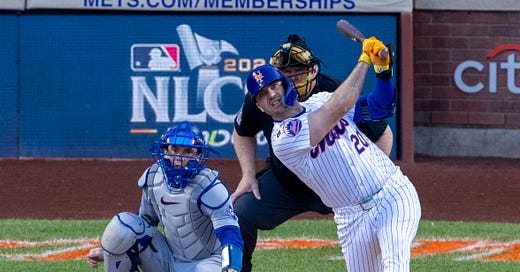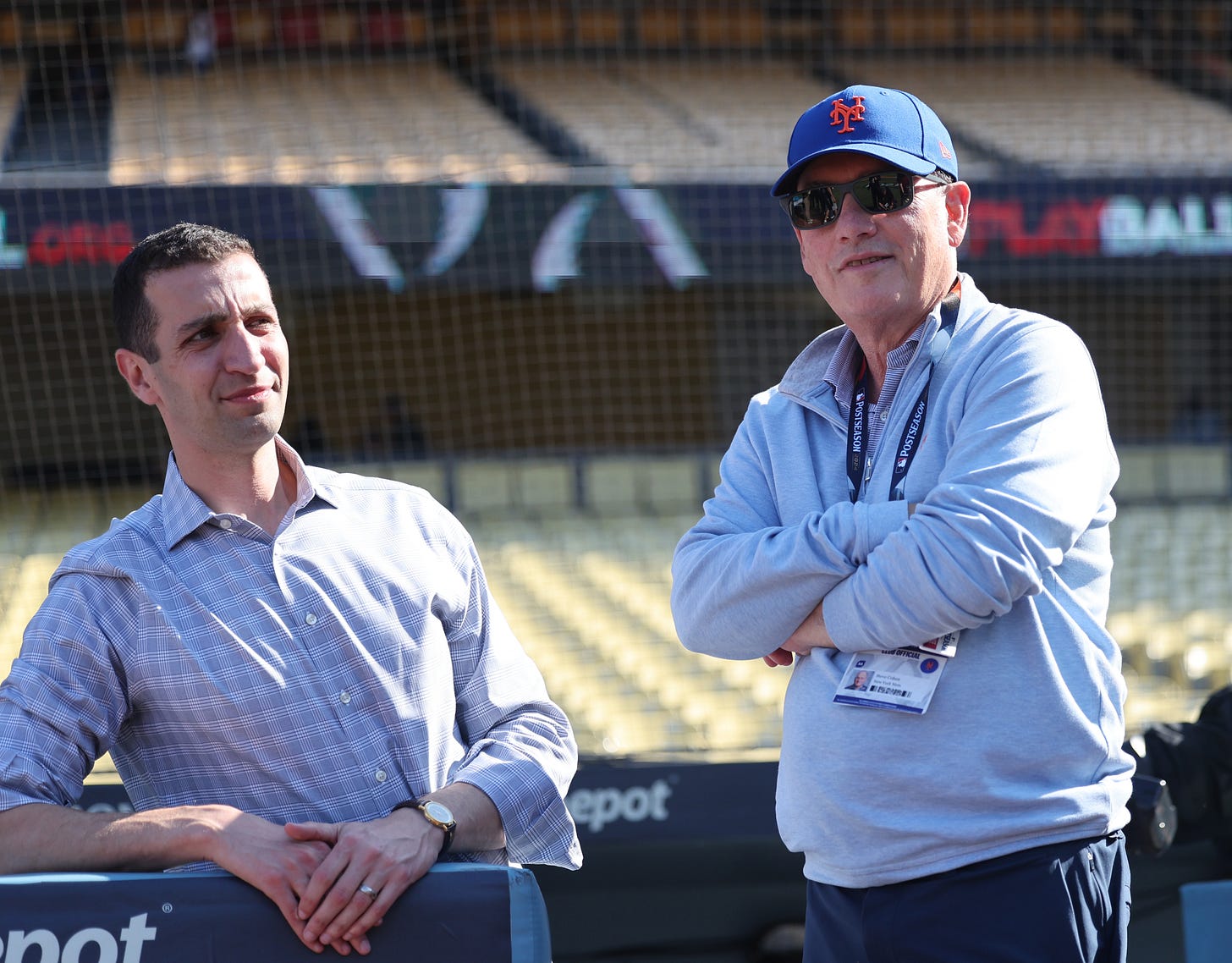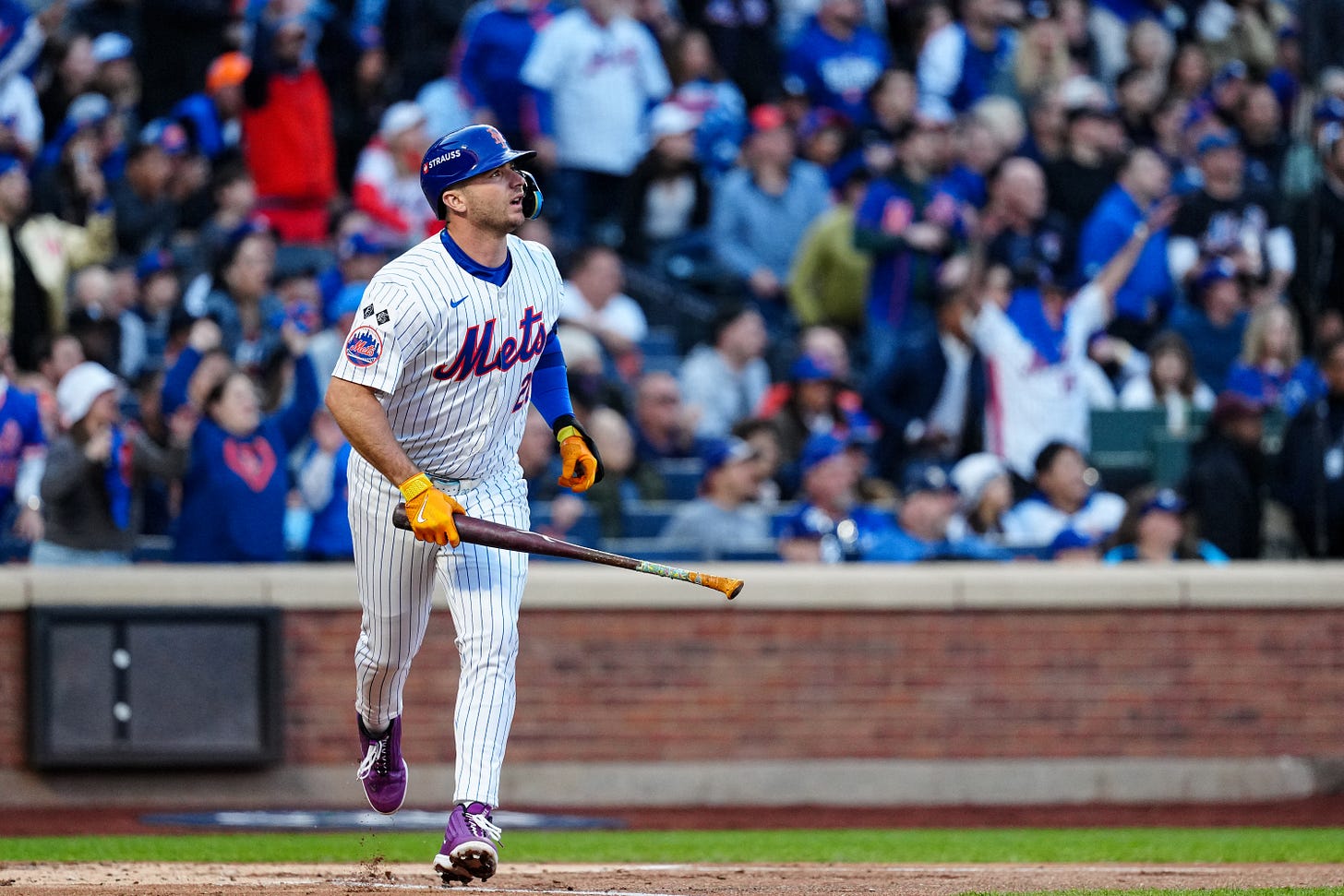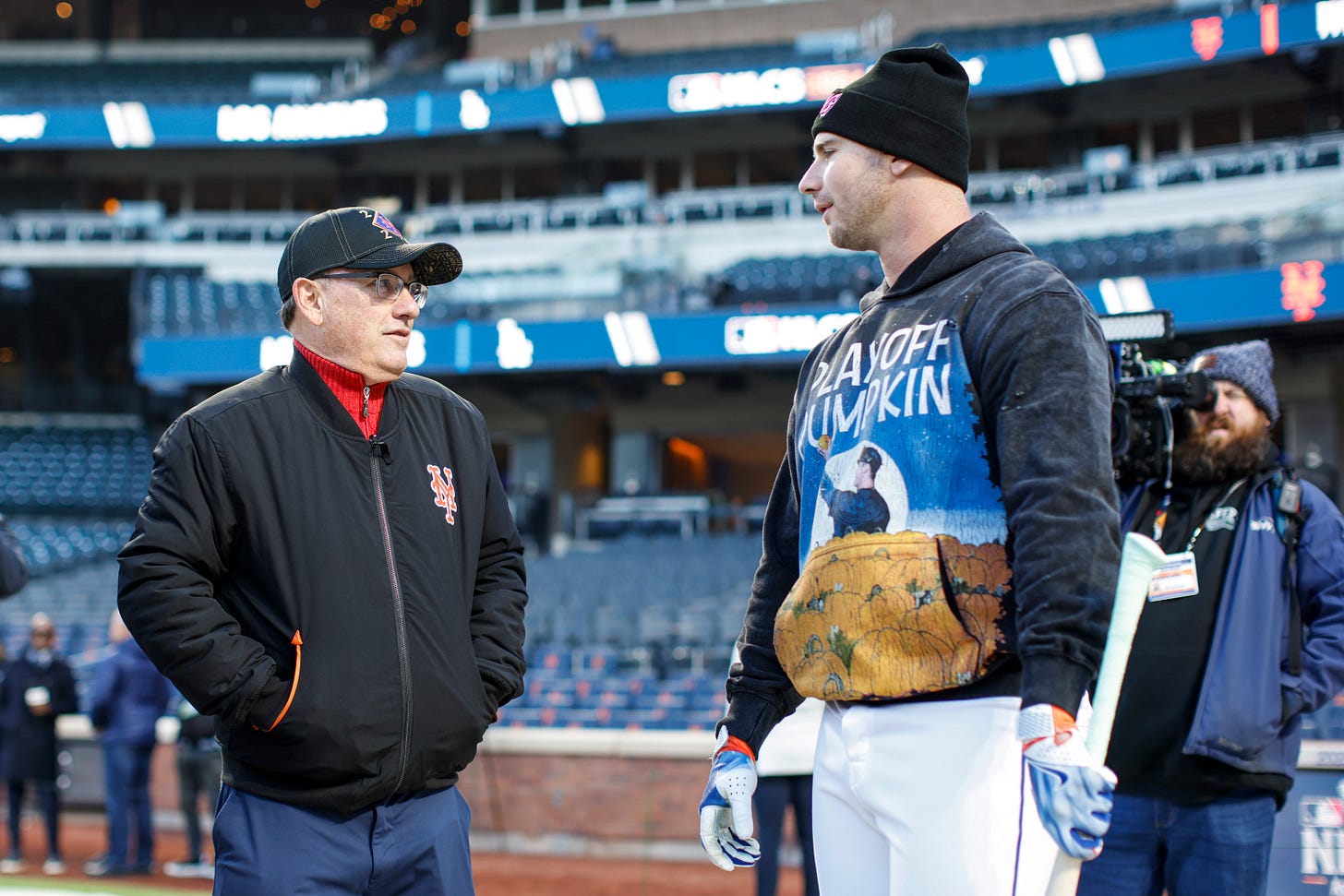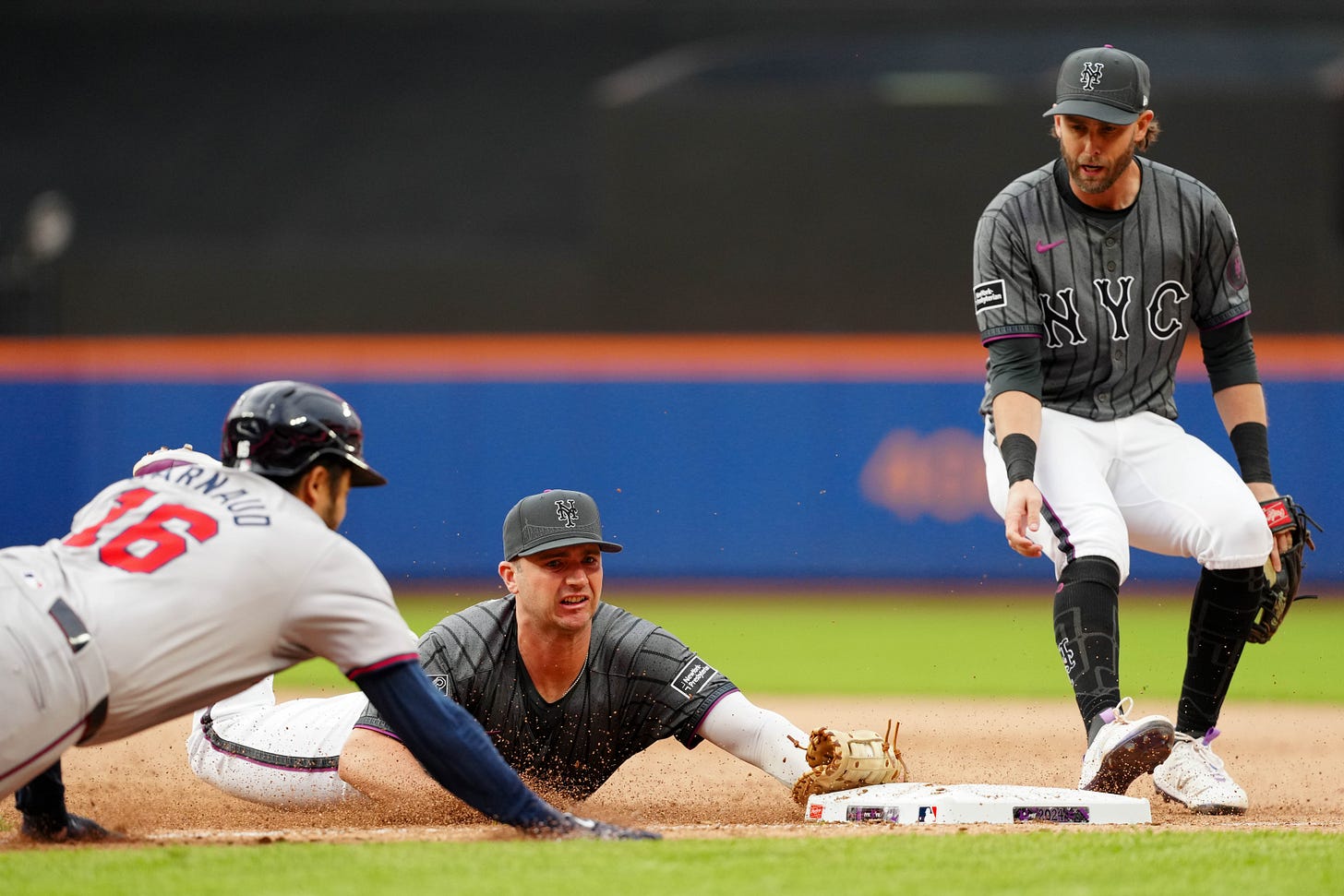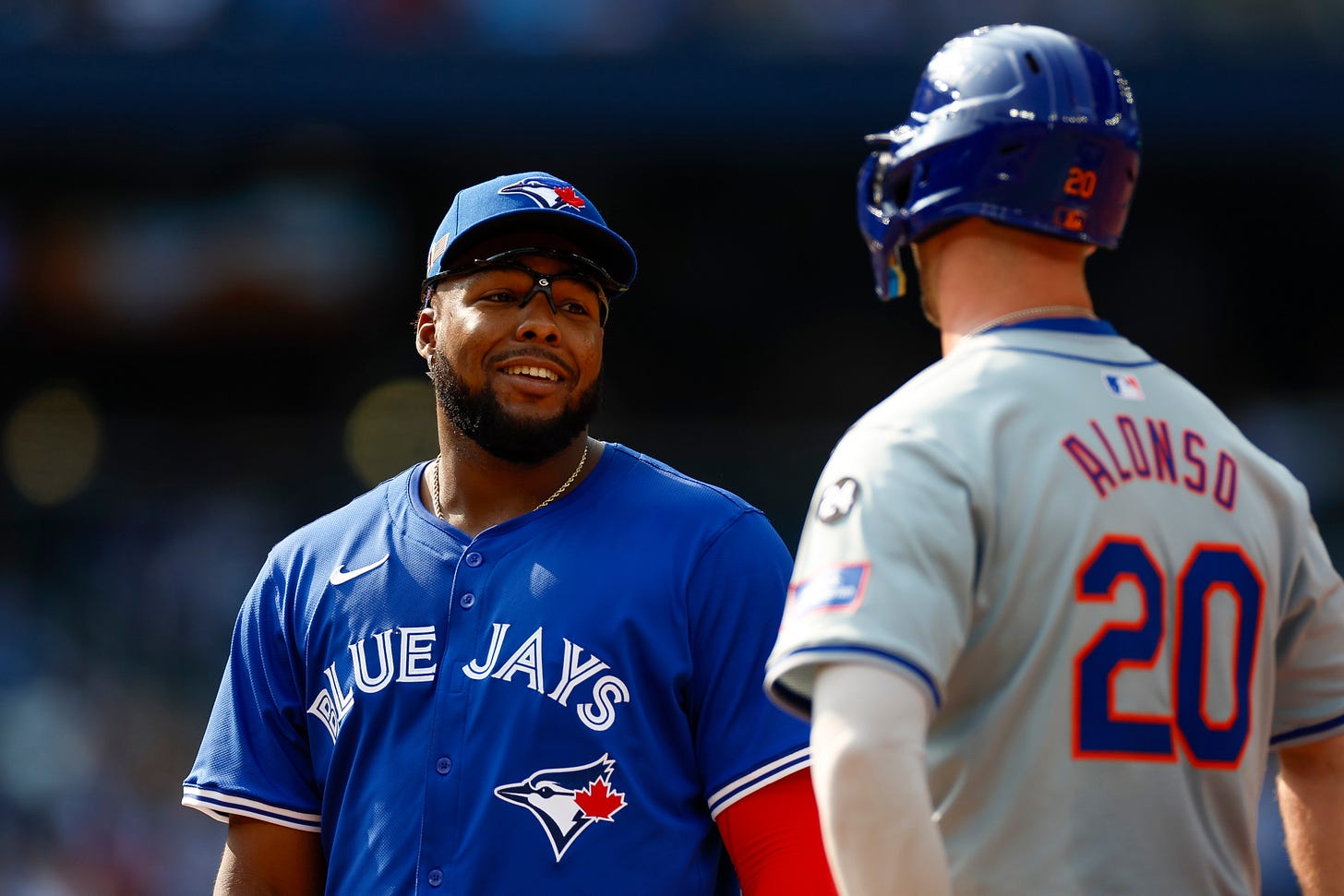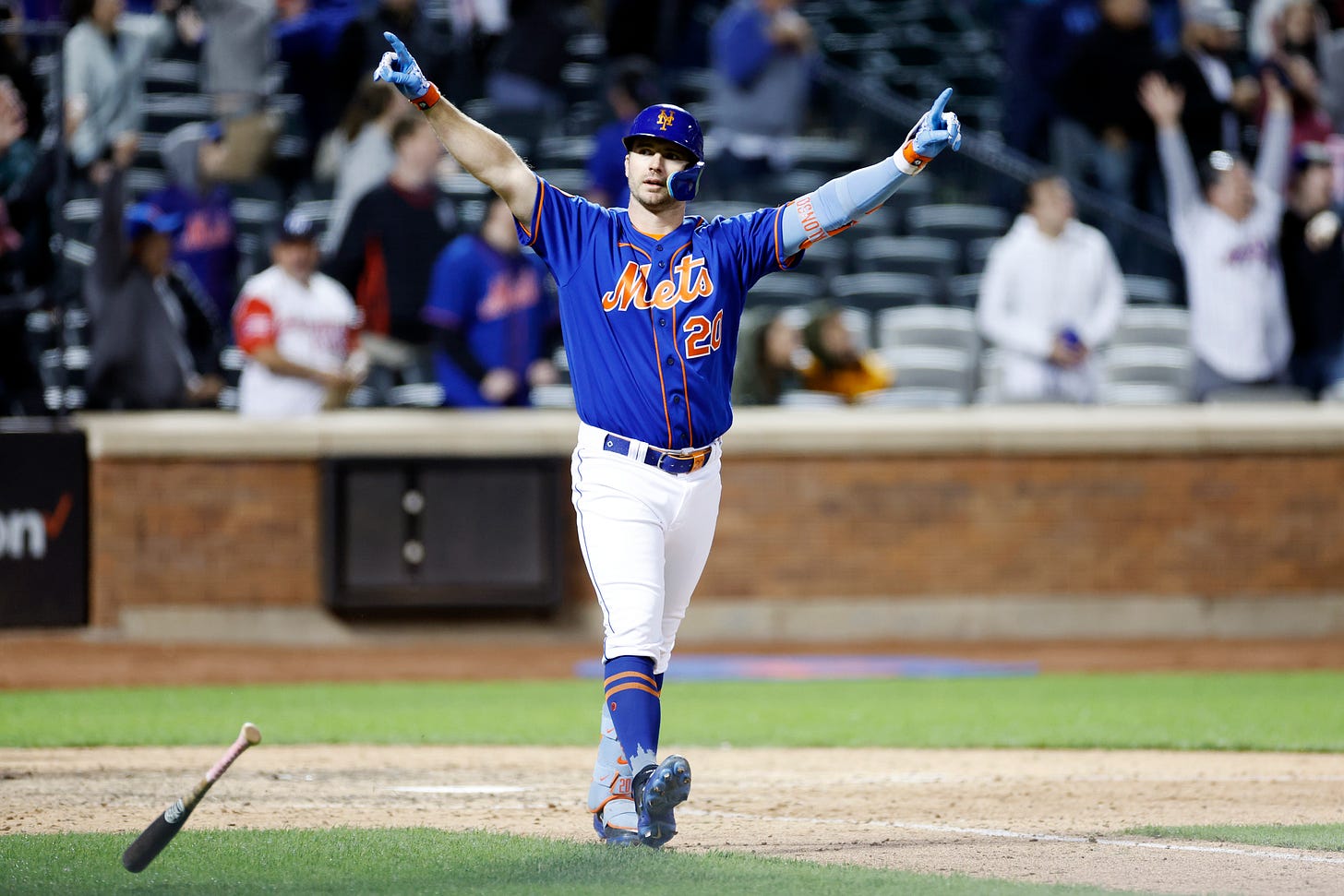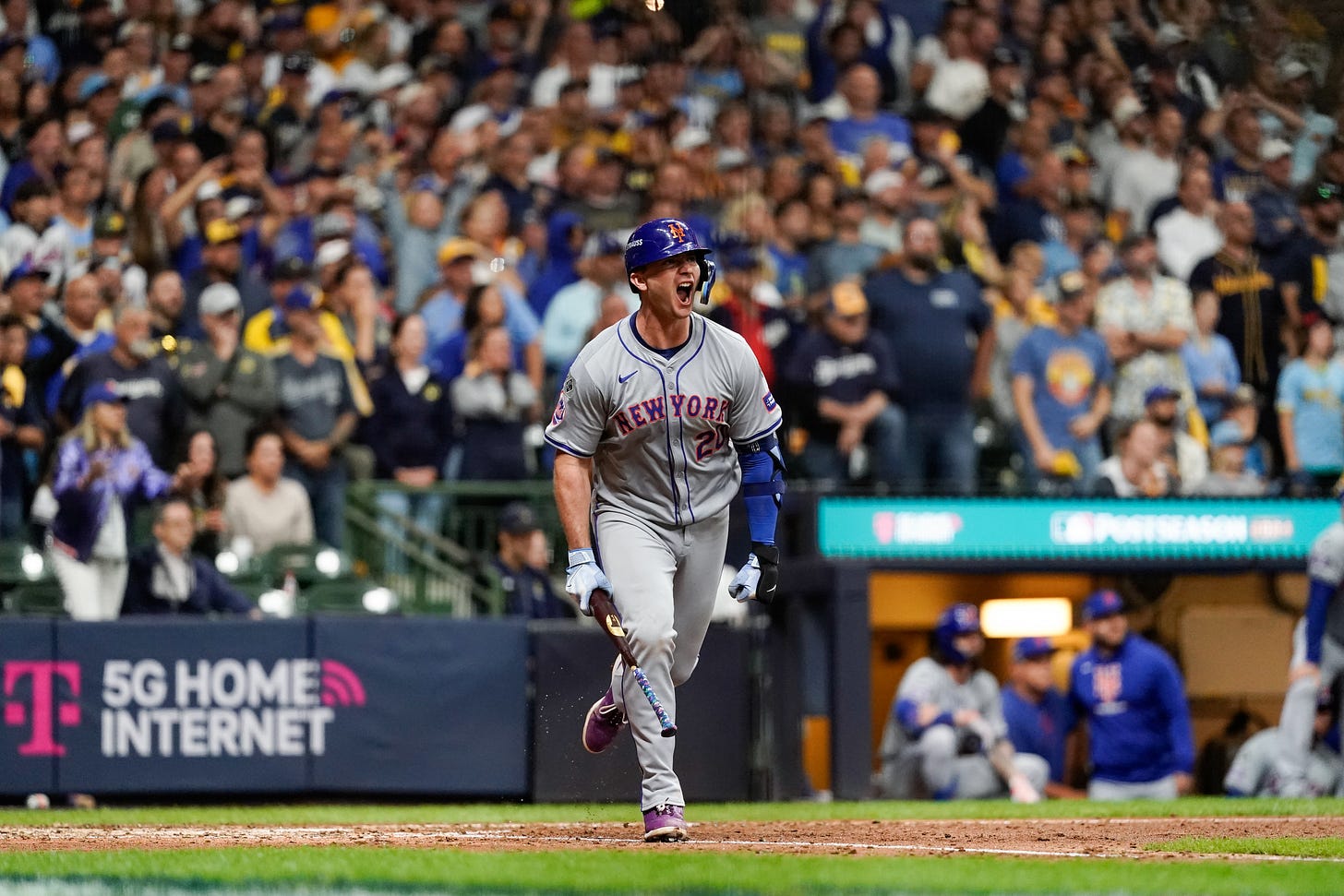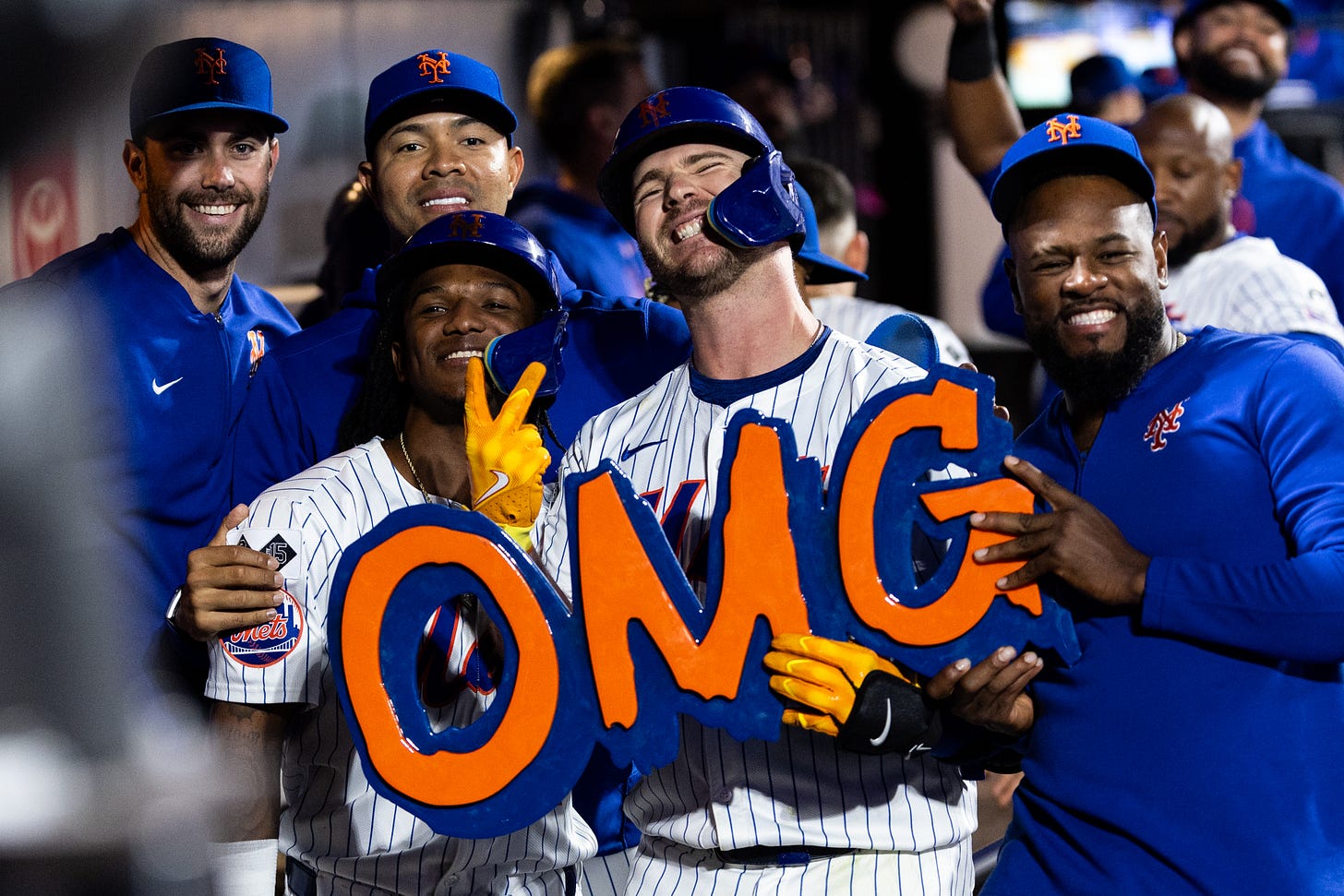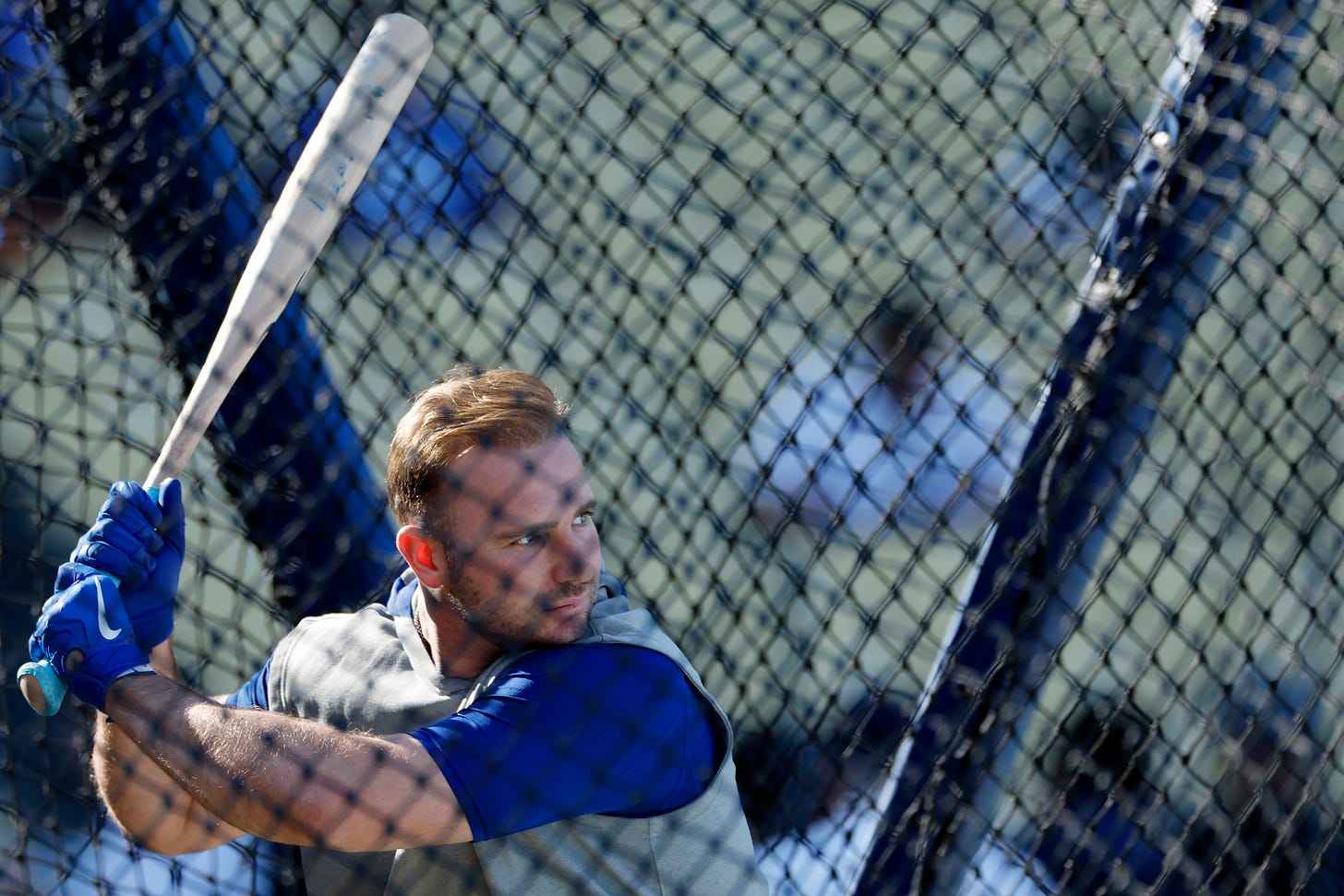Polar Pressure: What's The Ceiling?
A reunion that felt inevitable — while Alonso’s future is not.
While Friday’s are for prospect deep dives, bigger news takes precedent.
This past Wednesday, Pete Alonso and the New York Mets agreed to a 2-year, $54 million deal with a player option after the first season, and a $10 million signing bonus. Alonso also received $30 million upfront in the first year, making him the highest paid first baseman in baseball.
Pete Alonso’s back in Queens — with a king sized role.
MLB First Baseman’s Average Annual Values (AAV) for 2025:
Vladimir Guerrero Jr. $28,500,000
Bryce Harper: $27,538,462
Freddie Freeman: $27,000,000
Pete Alonso: $27,000,000
Matt Olson: $22,000,000
Christian Walker: $20,000,000
Through all the talks of $175-200 million for 6 to 7 years — it’s nice for a reunion to take place, back down here on earth.
Alonso’s $30 million upfront was something he didn’t get on another 3 year, $71 million deal the Mets offered with opt-outs, as well.
Jon Heyman and Mike Puma in the New York Post this week laid out in great detail — explaining how Steve Cohen and David Stearns flew down to Tampa on Tuesday night, meeting with Alonso and his agent, Scott Boras.
Alonso voiced his grievances of deservingness for a larger deal — and Steve Cohen explained the qualifying offer penalties of losing a draft pick, and how it was hurting him in developing a market. Steve Cohen was very clear in the Mets wanting Alonso back themselves, albeit at an appropriate timeline, and price.
“I was clear...I told him, I want you back. We want you back.”
Where’s the Jackson 5 when you need them.
It’s important for me to be clear, though: the Mets gave Pete Alonso a second chance. They can’t tag him with the qualifying offer again. These next two years are critical to Alonso flying or dying the rest of his career.
For over two months, a public negotiation never seen in New York sports unfolded for the baseball world to see. Place your blame where you see fit — on Pete Alonso, or Scott Boras. You can blame Pete Alonso for turning down a 7 year, $158 million extension in June of 2023, if you thought he really wanted to be a Met for life.
Deep down, nobody really knows if Pete Alonso wants to but himself — though I’d weigh closer on the side that he does. You can certainly blame Scott Boras, Alonso’s agent, who undoubtedly overplayed his hand, multiple times.
Pete Alonso was told he was either: better than he actually was, or that better offers in free agency were coming. In either scenario, it felt as if it was Scott Boras who dragged the negotiation on for weeks longer than it should’ve. No real blame falls on the Mets in any of this. They played the negotiation perfectly, never giving into outside pressure and speculation, while never bidding against themselves.
This second chance idea for Alonso is interesting. Alonso as a player, is interesting. If this was 10 years ago, he’d have no problem signing a very lucrative multi-year deal. This isn’t because prolific power has suddenly been devalued in baseball — I’d argue the opposite. The rudimentary issue with Alonso is his profile. In a sport where athleticism is showcased on a nightly basis, the new age style of the game doesn’t favor Alonso well.
With that being said, he’s athletic enough to play his position; the same position where he led the league in scoops and rarely gets credit.
Coming off 162 games played, it’s not his age that you can currently cite as the reason for his decline. You can cite declining OPS; but not declining in terms of Alonso physically breaking down. It’s the overall decline in baseball, maybe society, of appreciation for only the immediate and flashier good.
As the old saying goes, the grass is always greener.
I guess now’s a good a time as ever to quickly address the elephant in the room — Vladimir Guerrero Jr.
If given the opportunity, you swap Guerrero out for Alonso 99 out of 100 times. Make no mistake about it; but with that being said — Vladimir Guerrero Jr. gave the Blue Jays a Spring Training deadline to get an extension done.
Normally, players wait until the first day of the regular season, putting pressure on the Blue Jays and indicating to them that their superstar may want to test free agency. With a player option on the table after year one for Alonso, the stars are aligning to swap one for the other this time next year.
That deadline for Guerrero is February 18th, and is creeping up fast. I’ll hold off from touching the money on this one, but it’s certainly a possibility as of this moment.
I do think it’s important to focus on what Pete Alonso means to this current Mets team — because there’s still a path for him to become a Met for life. If Alonso puts together two great seasons over the course of this contract and is willing to DH — I see no reason why a 4-5 year extension wouldn’t be the worst thing in the world.
Alonso, 30, with a December birthday, will be 32 in three full seasons from now. An extension after his second season for 4 years puts him at age 36, easily enough for Alonso to eclipse 400 home runs and be a one-year mercenary the rest of his career. Even after 5 seasons of 35 home runs, it would get Alonso to 401 — a very reasonable milestone to hit. At that point, who knows if Alonso wouldn’t consider retiring.
With Ryan Clifford coming up in a year or two, it’s important to think about a year or two down the line.
So I mentioned 400 home runs. Let’s talk about 500.
Only 28 players in MLB history have reached such milestone. Every single one of them (who were clean) have made the Hall of Fame.
I’ve fallen very guilty the past couple of years into believing that number was very attainable for Alonso. He had 146 home runs after the 2022 season, with a projection at the time for 400. If we sit back and do the math, at 226 now, Alonso would need five seasons of 50 home runs to only get to 476 — 24 away. If Alonso were to average 40 home runs for seven straight seasons, or 31 home runs for nine straight seasons, he’d eclipse 500 with 505 and 506 home runs — solidifying his Cooperstown case.
That’s a long, long time from now. Alonso has to do one thing: prove his worth for this season. If he can do that, he can recoup some of his lost value. Alonso will make approximately $55 million from this upcoming season and the last, leaving about $100 million, at least, on the table that I’d imagine Alonso would want to make up. This next season does have pressure on Alonso, but not in the way we commonly think. This isn’t a contractual walk year, even if the ball is in Alonso’s court to opt out or not.
The perception of him in New York, and whether or not the lights are too bright, is at hand. Alonso’s risen to the occasion before (Milwaukee); but has to go out and prove what he couldn’t last year — he’s not a declining one dimensional player.
Alonso’s hit .271 before. He’s been able to hold a walk rate above 10%.
While the average may not be like it was in 2022, I think that Alonso’s walk rate has a chance to be the best for his career. The opportunity in front of Alonso is profound — where he may be forced to be pitched to in many situations. Others? Could be pitched around. Depending how this lineup is constructed, a common question right now, where Alonso hits can change with just a little more plate discipline. Hitting in the same batting cage as Juan Soto may help Pete Alonso lay off a few more pitches than normal over the course of the 2025 season. In the same way you can make a case for Juan Soto batting 2nd or 3rd, you can make the same case for Pete Alonso, as well.
Even though I think he’ll end up remaining as the cleanup, 2 and 3 are interesting.
A homegrown star in his own right, the pressure is now on Pete Alonso to preform. Some don’t let it break them, and Alonso showed in Milwaukee that he may have that mentality. From dropping a foul ball in Milwaukee, to one of the biggest swing in Mets history, Pete Alonso showed he may be alright. He has to prove it, one last time.
41 HR, 112 RBI, .253/.355/.521, .876 OPS (134 OPS+, 142 wRC+), 10.6 BB%, 129 K, 3.6 WAR
That’s about how I project Alonso’s 2025. Slightly bullish, I know.
I’d hope that the power numbers stay where they are, with a comfortable floor of 40 home runs. Sure, last season was an aberration for Alonso; but I don’t think another 34 home run, 88 RBI season is in the works. I could be wrong; but I’d think without dollars and cents constantly on his mind, the pressure isn’t as palpable. I’d hope that his plate discipline increases ever so slightly, and is able to reinvent himself. At 30 years old, there’s still time in a second half of his career. I hope with an uptick in plate discipline comes a downtick in his strikeout numbers, as well.
If Pete Alonso ends up opting out after this year — it means he had a monster season.
This has been the best offseason in Mets history.
Just about every single piece who the Mets should have brought back, they did.
Aside from a certain starter, bat, or relief arm you may have wanted, once the Mets signed Juan Soto, everything after was more-so a bonus, rather than a necessity. In the case of Alonso, you could certainly argue his bat, even for one year, warranted enough necessity in its own right to be brought back. As the Mets get ready for spring training next week down in Port St. Lucie, there’s a lot to be excited about. I had the Mets at 88 wins before they signed Pete Alonso. Now, I have them at 93. The Mets have one of the best offenses on paper in baseball, with a legitimate lineup to not only compete for the division, but win the pennant. With a subpar American League, you could make the case that winning the National League foreshadows a World Series win.
A long way to go; but once again, there’s a lot to be excited about with Mets baseball.
For the sake of argument, I have four separate lineups which I am perfectly content with, and I imagine the Mets are, as well. The big question is where Juan Soto, and now Pete Alonso, will bat. This, along with the health of Ronny Mauricio, along with bounce-back campaigns from Brandon Nimmo and Francisco Alvarez.
The first, and the most likely, lineup:
Francisco Lindor (SS)
Juan Soto (RF)
Pete Alonso (1B)
Brandon Nimmo (LF)
Mark Vientos (3B)
Jesse Winker (DH)
Francisco Alvarez (C)
Jeff McNeil (2B)
Jose Siri (CF)
The second, my ideal, lineup:
Francisco Lindor (SS)
Mark Vientos (3B)
Juan Soto (RF)
Pete Alonso (1B)
Brandon Nimmo (LF)
Francisco Alvarez (C)
Jesse Winker (DH)
Jose Siri (CF)
Jeff McNeil (2B)
The third, once Ronny Mauricio and Luisangel Acuna enter the equation:
Francisco Lindor (SS)
Juan Soto (RF)
Pete Alonso (1B)
Brandon Nimmo (LF)
Mark Vientos (DH/3B)
Francisco Alvarez (C)
Ronny Mauricio (DH/3B)
Jose Siri (CF)
Luisangel Acuna (2B)
The fourth, and least likeliest, 2023-esque lineup:
Brandon Nimmo (LF)
Francisco Lindor (SS)
Juan Soto (RF)
Pete Alonso (1B)
Mark Vientos (3B)
Jesse Winker (DH)
Francisco Alvarez (C)
Jeff McNeil (2B)
Jose Siri (CF)
No matter what lineup the Mets send out there, it’ll be one that can compete. With Pete Alonso now back in the Mets lineup, he’s one of the three cylinders in this Soto-Lindor-Alonso engine. If Alonso has a good season, the Mets likely do, as well.
The Mets ceiling is a World Series with Pete Alonso in Queens.
In regards to the rest off the offseason, I’d say the Mets are fairly set across the board. If I could make one more addition, it would be for another left handed reliever to compete with Danny Young. At this point, I’d try to bring back Brooks Raley on a one year, $4.5 million deal, stash him in the bullpen until July-August, just in time for a playoff run.
Excited to see what spring training tells us — and that’s always a lot.


